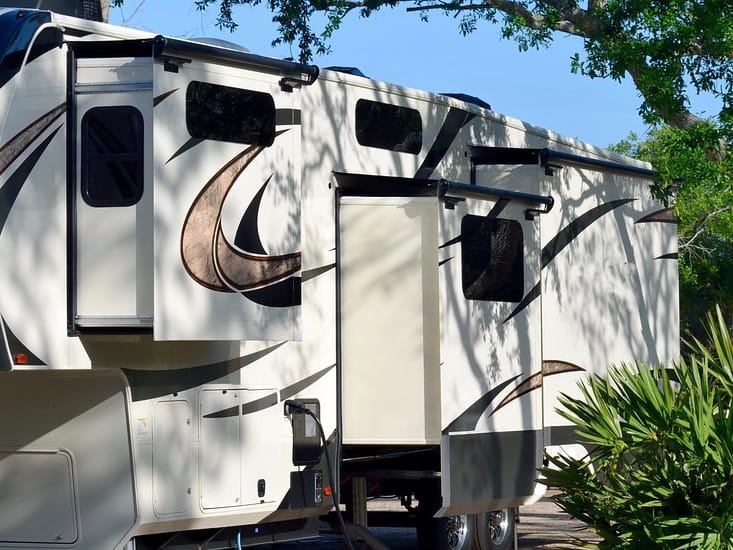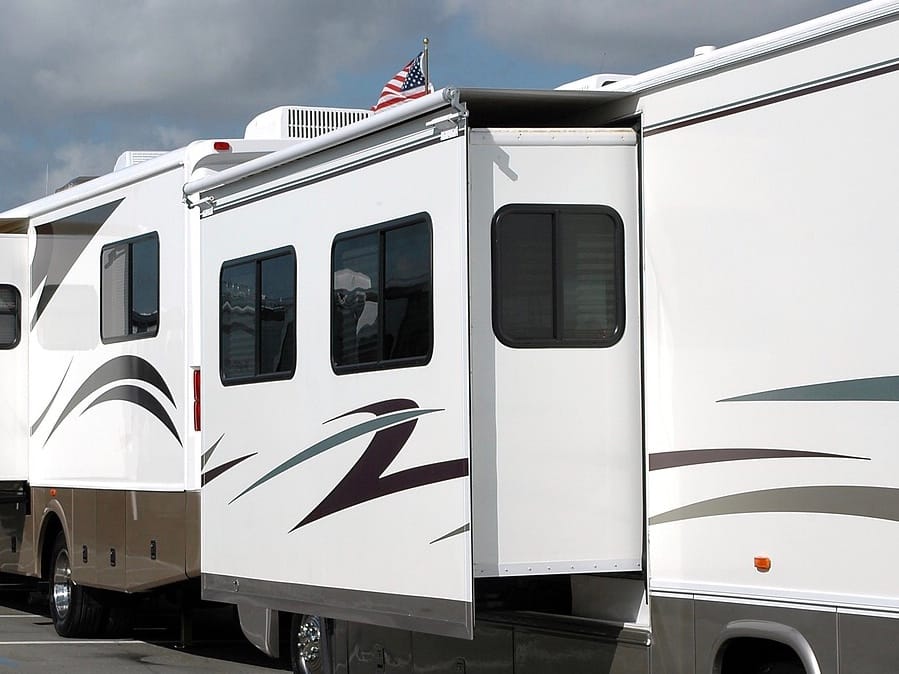This article may contain compensated links, please read our disclaimer for more information.
One thing that doesn’t get discussed enough in the world of RVing? RV slide toppers. These handy things are fairly common, and yet we rarely hear about their uses, how to care for them, or how to repair them.
In today’s article we will fix this problem by addressing some of the most important bits of information you should know about your RV slide toppers. After reading, you should have a much better understanding about why we use slide toppers and how you can ensure yours lasts as long as possible.
Let’s get started!
What are RV Slide Toppers?
First, let’s talk briefly about what exactly an RV slide topper is. After all, this isn’t a very useful discussion if you don’t know what we’re discussing.
Slide toppers are the small awnings you see sticking out over the slides on some RVs. They automatically roll out when the slides are put out and retract when the slides are pulled back in. Some RVs come standard with these small awnings, others do not. That said, it is possible to add your own aftermarket RV slide toppers, something many RV owners choose to do.
What are Slide Toppers for?
Now that you know what we’re talking about, you may be wondering what exactly slide toppers are for. The obvious answer is that they help protect your slide roof from leaks. They also do a nice job of keeping debris off the roof, and any debris that falls onto the topper tends to slide off easily, rather than getting stuck on the flat slideout roof.
Another major benefit of RV slide toppers? These things can actually help insulate your RV and provide extra shade from bright sunshine. This is awesome because it means cooler summers and warmer winters without using a ton of electricity or propane.

The Drawbacks of Slide Toppers
As you can see, there are a few great benefits to having toppers over your slides. That said, these awnings do also have some drawbacks.
For one thing, slide toppers can catch the wind, causing annoying flapping noises that can make it hard to sleep. They can also collect rainwater, dropping it at random and sometimes at the most inopportune times. There is also the fact that it’s another thing on your RV that you have to maintain, and lastly, we find it very annoying that the slide topper must be removed in order to reseal the slide roof underneath.
If you find these drawbacks are terribly annoying and you want to remove your RV slide toppers, you can do that by using the video below to remove the awning fabric, and then using a drill to remove the topper hardware.
Are RV Slide Toppers Necessary?
Overall, even with their negatives, RV slide toppers are pretty nifty, but are they a necessity? If your rig didn’t come from the factory with them, should you rush out to buy a set right away?
We’d have to say that no, although RV slide toppers are super nice to have, they are not at all necessary, especially if your RV didn’t come with them in the first place. There are plenty of RVs out on the road without slide toppers that are doing just fine. Just make sure the rooftops of your RV slides outs stay well sealed and you’ll be good to go.
All that said, if you do want to add aftermarket slide toppers, you can do that using something like this. Be sure you choose one that fits your slide!
Caring RV Slide Toppers
If you do have slide toppers, you may be wondering how to care for them. The good news is that they are very easy to care for. Below are our top tips for taking excellent care of your RV slide toppers.
Clean Often
You should clean your slide awnings every time you clean your RV. This will help them better retain their original color and will help ensure they don’t accumulate mildew or mold.
Washing your slide topper is as simple as scrubbing them gently with a long-handled brush and a mixture of water and dish soap. Rinse with water and make sure to let the topper dry completely before pulling it in.
Pull Them In During Strong Winds
Slide toppers can be damaged by high winds and heavy hail. Therefore, it’s a good idea to pull your slides in if the wind gets going strong or if a big storm rolls through.
Not only will this prevent holes and tears in the awning fabric, it’ll also make your rig more aerodynamic, making it harder for the wind to push you around as you wait for the storm to pass.
Regularly Inspect for Tears
Even well-taken-care-of slide toppers will begin to tear over time. This is just a part of the aging process and will happen more quickly if you spend a lot of time parked in the sun.
Fortunately, you can get more life out of your slide topper fabric even after the tears begin to show up. To do this, inspect the fabric before you pull in the slides each moving day. If you find a tear, use awning tape to patch it up before retracting the slide topper to avoid further damage.
Replace Fabric as Needed
Eventually, you will have to give in and replace the RV slide topper fabric entirely. Fortunately, this is something most individuals can do without the help of a professional. That said, you will likely need a second set of hands to make the process go smoothly.
There are a couple of ways you can replace your awning fabric. The traditional way of doing this is shared in the video below:
That said, many find they prefer the method shared in this next video:
No matter which method you use, you’re sure to appreciate having a new slide topper fabric in place so you can enjoy the benefits of having functioning RV slide toppers once again!
What do you think? Are slide toppers worth having? Will you install a set on your RV? Hopefully, this article helped you better understand what slide toppers are and how you can care for any toppers you might have on your rig.
Join Fulltime Families
Fulltime Families Members get access to the best resources, community and discounts.
Fulltime Families is a participant in the Amazon Services LLC Associates Program, an affiliate advertising program designed to provide a means for sites to earn advertising fees by advertising and linking to amazon.com, amazon.co.uk, amazon.ca. Amazon and the Amazon logo are trademarks of Amazon.com, Inc. or its affiliates.

